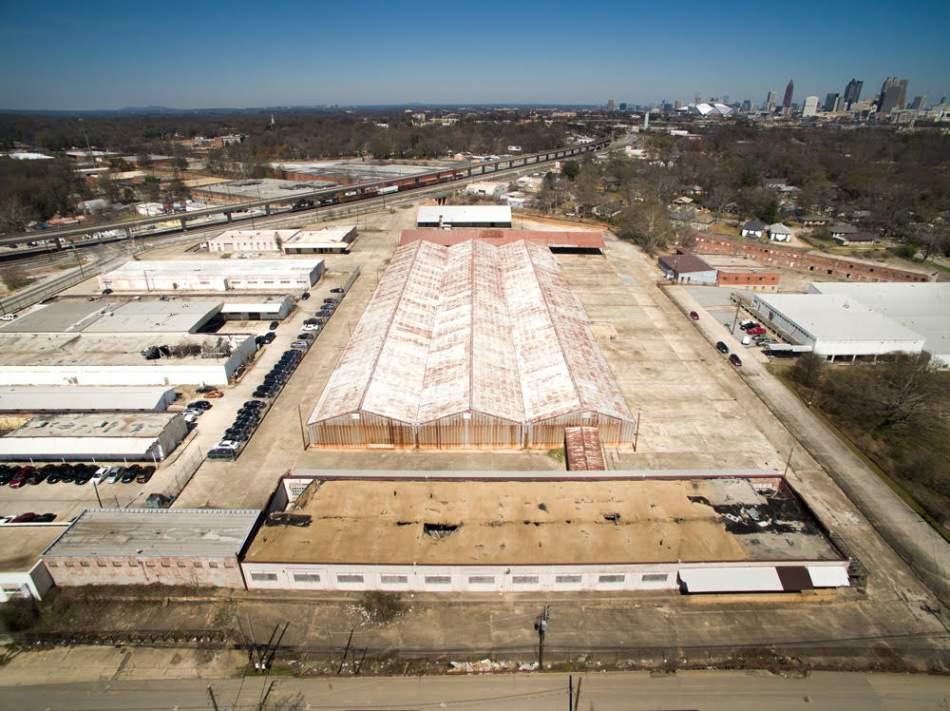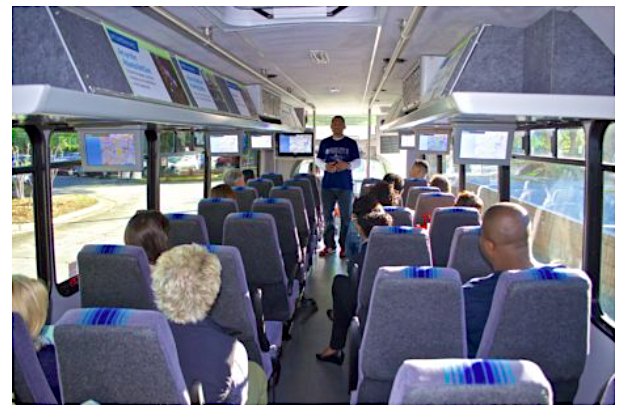In this Letter to the Editor, longtime Atlanta BeltLine Partnership volunteer Sundiata Rush waxes poetic about the transformative potential of the Murphy Crossing warehouse property in Oakland City.
In April, the BeltLine issued a request for proposals from developers with visions for purchasing and remaking the 20-acre, historic property bordering the BeltLine’s Westside Trail. The deadline for those proposals is Tuesday.
Rush, an Atlanta native, has been involved with the BeltLine and communities bordering it as a consultant and tour guide since 2007. He writes:
...
At the heart of 1050 Murphy Avenue in Southwest Atlanta, Building 10 is a tease.
Shut-in doorways withholding tales of the past adjoin an open dock yearning for future deliveries. Swaths of missing sheet-metal on the roof expose rusted steel ready for reconstruction. Weathered, neglected bricks want new purpose. But as with the other battered and abandoned structures on the property, revival seems imminent.
Don’t look now, but Murphy Crossing is on the come-up. A new spirit is in the air, fresh plants are in the ground, and movie cameras are shooting inside. Indeed, the audacious BeltLine path next door is stoking change.
Today, MARTA’s 79 bus is the only public transportation route with a connection to the old Atlanta State Farmers Market. Tomorrow, as I envision it, light-rail BeltLine transit, with close links to MARTA rail and the Atlanta Streetcar, will deliver shoppers directly to hip boutiques and custom retail, and commuters will pop into coworking space, an entrepreneurs’ village, and a natural-foods grocer.
Today, at the property's driveway on Murphy Avenue, a cluster of bent steel poles shoots haphazardly from the ground as a barrier to entry, and a patchwork of ancient concrete blankets most of the site.
Tomorrow, signature art pieces will frame gateways welcoming visitors to community festivals and crunk events. A multipurpose greenspace will host family picnics and bootcamp classes. And wide connected promenades will usher pedestrians to office foyers, café patios, popsicle carts, and townhome stoops.
At the southeast corner of the property, the backside of Building 13 hugs the bend in the BeltLine where freight trains once loaded and unloaded. Today, random holes pierce the walls, and the sealed elevator shaft fronts weeds beside the corridor. Boarded-up and desolate, only the overgrown vines thrive here. But the location is a blessing.
 The 20-acre property's scope, bordered by a MARTA line in Southwest Atlanta.Photo by The Sintoses, courtesy of Atlanta BeltLine Inc.
The 20-acre property's scope, bordered by a MARTA line in Southwest Atlanta.Photo by The Sintoses, courtesy of Atlanta BeltLine Inc.
Tomorrow, the scent of fresh-roasted coffee and just-baked sweets will waft from shops on the ground floor, and residents of retro lofts above will exit the elevator for a morning jog or evening stroll on the trail.
For generations, winter winds have whistled through locked gates, broken windows, and blight at this 20-acre site. But spring is on the horizon.
While proposals for Murphy Crossing are currently being re-stirred, the emergence of the Westside Trail has already sparked renewal in the neighborhood. A stone’s throw west, a row of vacant warehouses has been converted to a brewery, event space, and a string of retail along White Street. In Murphy’s backyard, the once contaminated grounds of a repair garage for coach buses have been cleaned, re-soiled, and remade into an urban farm.
Every fourth Saturday, on a former industrial property within walking distance of Murphy Crossing, Atlanta Indie Market hosts a spry pop-up gathering of homegrown artists, designers, and performers showcasing their talents and wares as part of a “community kickback.” Next door on Warner Street, the languishing remnants of a bygone baking plant are set to be replaced with the buildout of Trees Atlanta’s future headquarters and outdoor classroom.
And in the tunnel below Murphy and Lee streets, where CSX and MARTA lines run above, introspective and whimsical murals like “If I were a bird (Meditation for Peace)” by Sachi Rome and “Parade of Animals” by local families and Paint Love offer colorful inspiration for passersby on the trail.
All of this foreshadows what’s to come at the Crossing.
Back in the day, the site was a bustling hub of produce, people, and progress. More than a dozen buildings, varying in size and structural composition, accommodated merchant stalls, open sheds, table stands, and storage units, all brimming with fresh fruits, vegetables, nuts, and other treats. During peak harvest times, delivery trucks and customers often waited in traffic jams just to gain entry. The market anchored a growing business and residential community, spawned in part by legend…
Long ago, Anthony Murphy, a foreman for the Western & Atlantic Railroad Company, became a folklore hero in town for helping recapture “The General,” the famed locomotive stolen by the Yankees in Kennesaw during the Civil War. Serving several terms on Atlanta City Council, he was also a catalyst in the development of the city’s Waterworks complex and helped establish the Atlanta Public Schools system.
Murphy lived in this area, and neighbors routinely touted his ability to help attract business. Commerce sprouted in the neighborhood; what was Jacobs Drive became Murphy Street; and in the early to mid-20th century, a medley of industries called it home, including The National Biscuit Company (Nabisco), and The Hanson Motor Company—maker of the Hanson Six, the first and only automobile to be fully manufactured in Atlanta.
In time, the State Farmers Market, previously downtown, relocated here and quickly became the center of activity. Its site—the crossing of two major railroads—also donned the Murphy name, a nod to the local hero.
That activity has faded, but in a similar holistic vein, the Atlanta BeltLine is fueling a new era of business, culture, and connection. Indeed, a syndicate of neighbors, community leaders, and project stewards is aligning goals and crafting a blueprint for a defining asset at the nexus of Adair Park, Oakland City, and Capitol View neighborhoods.
Today, graffiti peppers the walls of almost every building on site, echoing the angst of area residents who’ve stared at wasted space and dilapidated infrastructure for decades.
Tomorrow, deft crews of painters, dancers, and rappers will present art throwdowns and freestyle battles to benefit area youth. Maker fairs will inspire kids young and old to imagine, build, code, and create. And a bold arts collective will curate off-beat exhibits, open-mics, and DIY workshops.
Today, next to the backyards of Brookline Street homes to the north, kudzu and thickets grow wild in a deep ravine.
Tomorrow, neighbors will gather around pop-up merchants and impromptu jams at a public plaza next to the rail line, and kids from Bearings Bike Shop will pop wheelies from that nonprofit’s backdoor directly onto the loop.
But of all the great potential on site, Building 1 may be the gem.
One peek inside sends your eyebrows high and imagination churning, wondering what could be. No wonder filmmakers have caught on and are now using it as a canvas.
Years ago, the space functioned as a warehouse for food storage and an indoor hall for vendor booths. Today, three spacious bays, side-by-side, stretch the length of a football field with not a wall or barrier between them. The open floor is studded with thick, industrial steel beams, rising in a succession of symmetrical pyramids to frame a set of high, arched ceilings.
Tomorrow, this chamber should be a premium social venue hosting banquets, movie screenings, and top-flight fashion shows. Companies will throw galas, civic groups will convene, chefs will thrill palates, and musicians will play Murphy Stage.
Tomorrow, on the BeltLine, Murphy Crossing will be a dynamic live-work-play-perform destination with the soul of the “SWATS” (Southwest Atlanta Too Strong).
Just feet from the backside of the property, across Allene Street, Allen Peterson’s sculpture “Phoenix: Atlanta’s Railroad Rebirth” stands tall and proud beside the Westside Trail. Old rail spikes and shoulder plates are fused and shaped into a majestic bird rising from dust. Its wings are spread wide, poised for flight. Its beak is open, chirping a tune.
If you look close, you might see the sparkle in her eye: the transformation of Murphy Crossing. And if you listen, you might hear the chorus of her song: progress.
• Atlanta BeltLine seeks buyer (again) for crucial Murphy Crossing site (Urbanize Atlanta)









